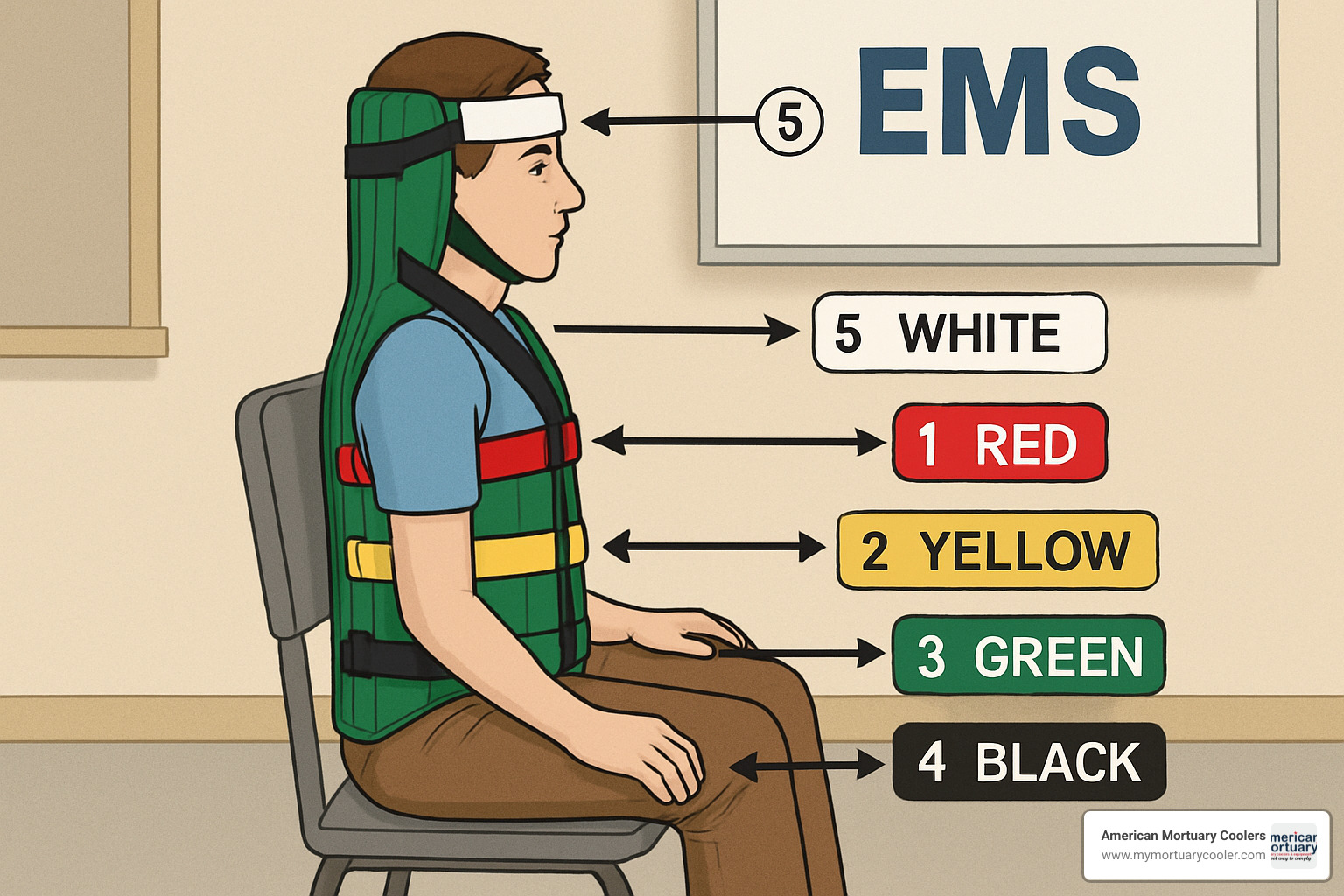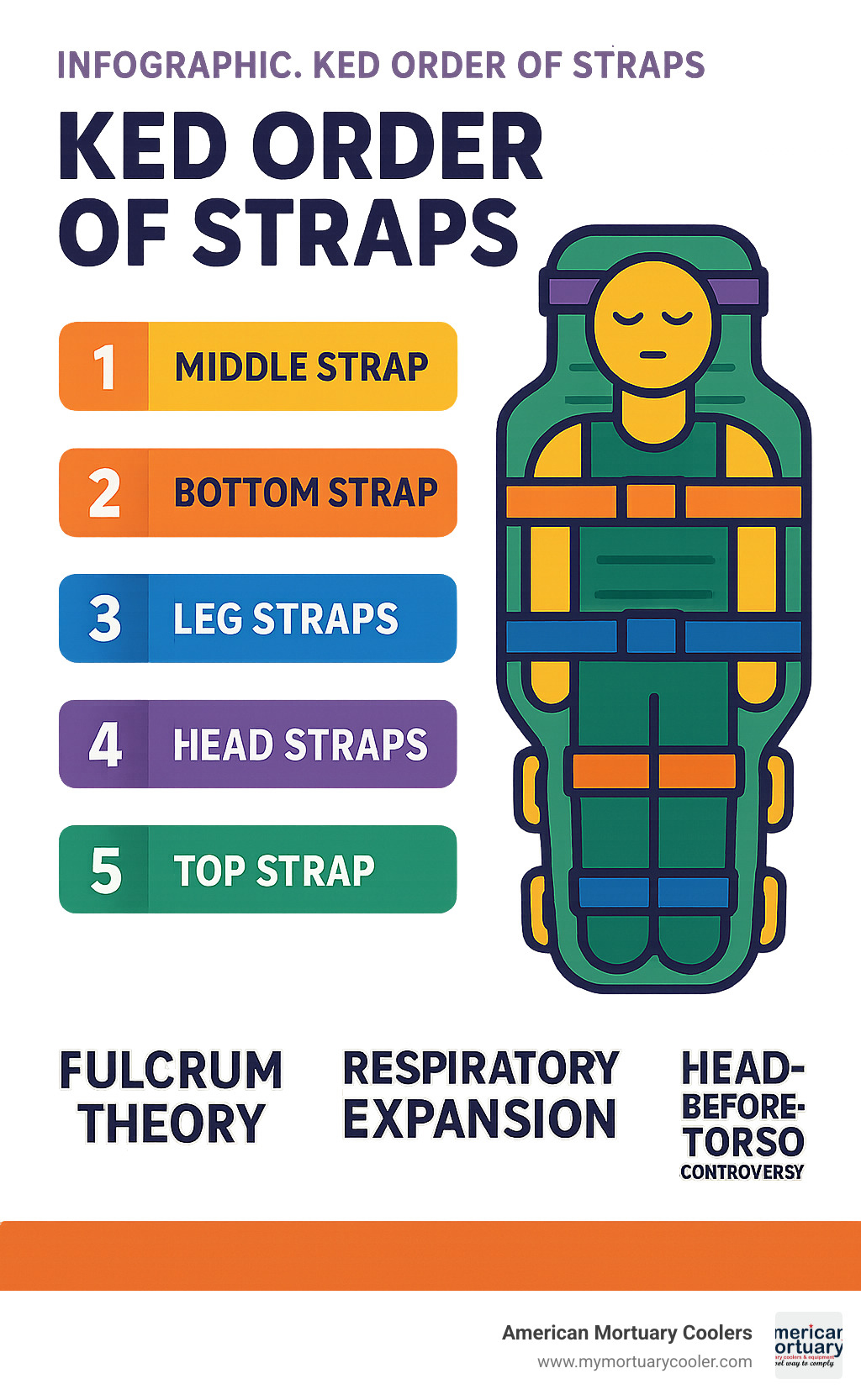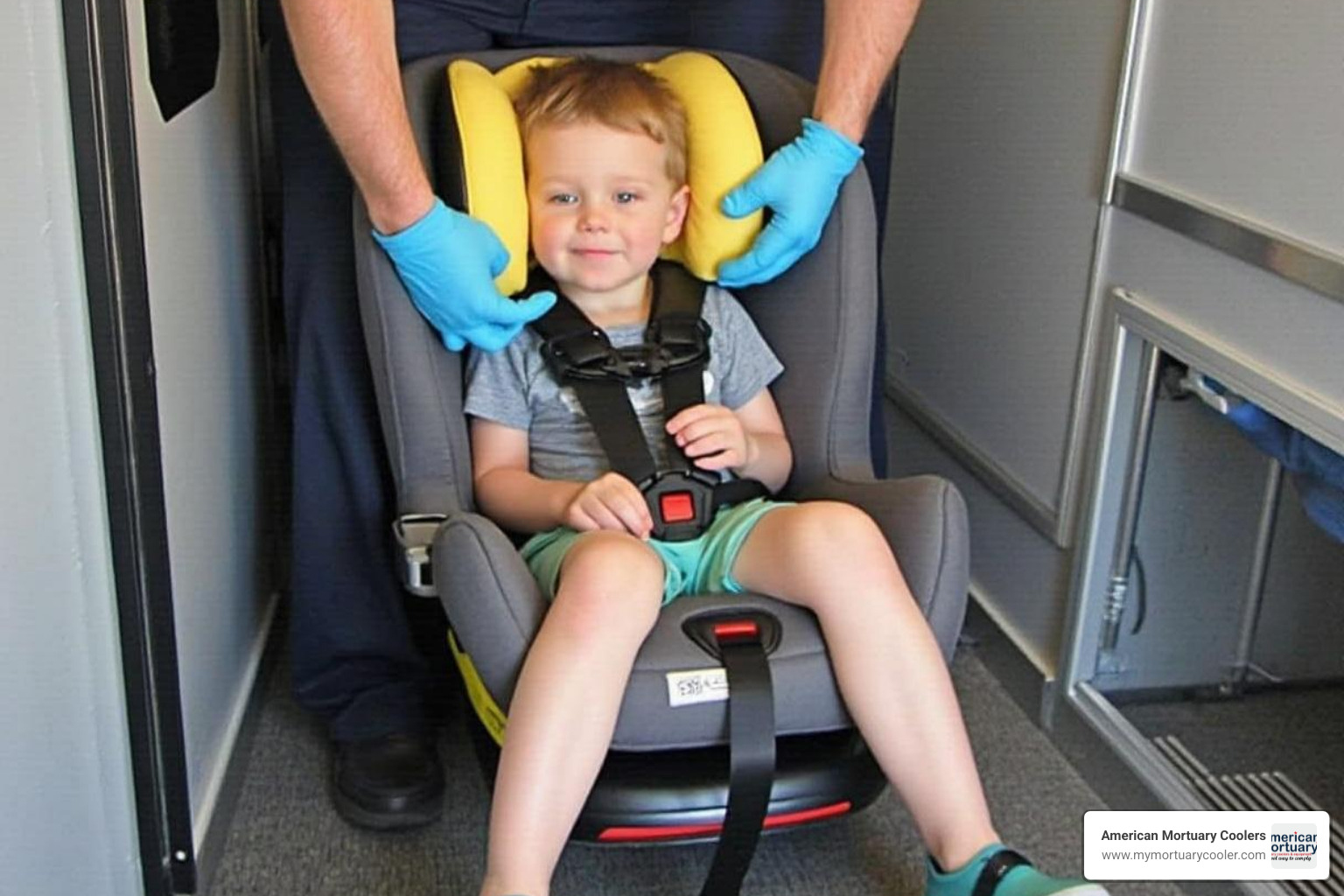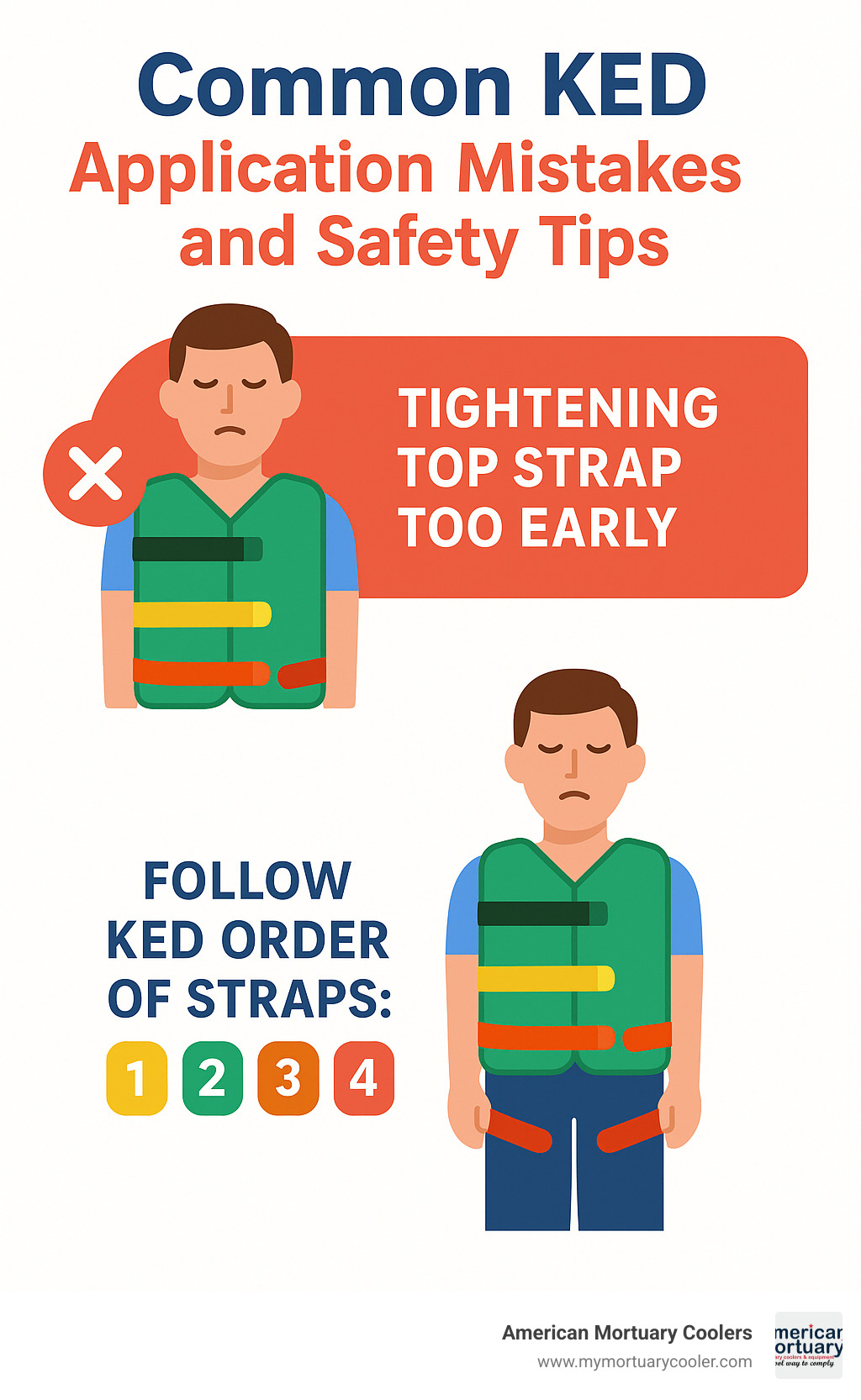Quick Answer: KED Order of Straps Sequence (5 Steps)
If you need the KED order of straps, here's the standard 5-step sequence recommended by the manufacturer and most protocols:
- Middle Torso Strap (Red)
- Bottom Torso Strap (Yellow)
- Leg Straps (Black)
- Head Straps (White)
- Top Torso Strap (Green)
Mnemonic to remember: "My Baby Looks Hot Tonight."
When time matters and patient safety is at stake, knowing the KED order of straps is critical for proper spinal immobilization during extrication. This step-by-step order ensures the KED (Kendrick Extrication Device) holds the patient securely—minimizing movement, supporting breathing, and protecting the spine. Tightening the straps in the correct sequence isn't just a formality—it's a proven way to get reliable immobilization with less risk of shifting or restricting the patient's chest.
"Applying the middle strap first minimizes leverage and shifting because it acts as a fulcrum; tightening torso straps before head prevents head strap readjustment and ensures a uniform, tight fit." (EMS instructor, as cited in recent forums)
I'm with American Mortuary Coolers, a national mortuary equipment supplier with deep experience supporting EMS teams and funeral professionals on best practices, including the KED order of straps. After years of hands-on work and helping others learn this device, I've seen how following this exact order can make your extrication smoother and safer.

KED order of straps related equipment:
Understanding the KED and Its Straps
Before we dive into the ked order of straps, let's get familiar with what we're actually working with here. The Kendrick Extrication Device—or KED for short—isn't just another piece of equipment gathering dust in your rig. It's a game-changer when you need to safely remove someone from a seated position after trauma.
Picture this: you're responding to a vehicle collision, and the patient is conscious but complaining of neck pain. They're wedged in their driver's seat, and there's no way a long backboard is fitting through that mangled door frame. That's where the KED shines.
What Makes a KED Tick?
The KED was invented back in 1978 by Richard Kendrick—and honestly, the design hasn't needed much tweaking since then. It's built around rigid battens (think sturdy wooden or polymer strips) wrapped in tough nylon fabric. These battens give the device its backbone, literally supporting the patient's spine during extrication.
Ferno, one of the most trusted names in EMS equipment, manufactures the standard KED that most of us know and love. The device features three torso straps, two leg straps, and two head straps—each with a specific job to do. The whole setup is designed for seated spinal immobilization, keeping your patient stable while you work them out of tight spots.
Here's what makes the KED so practical: it maintains respiratory considerations throughout the process. Unlike some immobilization devices that can make breathing harder, the KED's strap sequence is specifically designed to support the chest and allow for proper lung expansion. That's critical when you're dealing with trauma patients who might already be struggling to breathe.
Scientific research on KED effectiveness shows mixed results on clinical outcomes, but here's the thing—nearly every EMS protocol and state guideline still endorses using the KED. More importantly, they all emphasize following the proper ked order of straps for maximum safety and effectiveness.
Standard Strap Colors & Functions
Now let's talk about those colorful straps—and trust me, the color-coding isn't just for looks. When you're working under pressure, maybe in low light or with adrenaline pumping, those colors become your roadmap to success.
The red-yellow-green torso straps work together to stabilize the patient's trunk. Think of them like a three-point system that distributes pressure evenly while maintaining spinal alignment. The red strap hits the middle torso first—this becomes your anchor point. The yellow strap secures the bottom torso second, giving you that lower thoracic support. The green strap at the top comes last, and there's a really good reason for that timing.
The black leg straps might look simple, but they're doing heavy lifting when it comes to pelvic stability. These can be applied straight across or criss-crossed, depending on your patient's anatomy and any potential groin injuries you need to work around.
Finally, the white head straps complete the immobilization picture. These secure both the chin and forehead, but only after you've got everything else locked down. There's actually some debate in the EMS community about head-first versus torso-first approaches, but the manufacturer's recommended sequence has solid physics behind it.
The beauty of this color system? Even if you're training a new partner or working with mutual aid from another department, everyone can follow the same visual cues. No confusion, no second-guessing—just reliable, consistent patient care.
Step-by-Step Guide to the ked order of straps
The secret to mastering the ked order of straps comes down to one simple memory trick: "My Baby Looks Hot Tonight." This mnemonic has saved countless EMTs from making costly mistakes in high-pressure situations.
Middle, Bottom, Legs, Head, Top—in that exact order, every single time. Whether you're working a scene in the mountains of Tennessee or the busy streets of downtown Dallas, this sequence never changes.

Step 1 – Position the Device Behind the Patient
Getting the KED properly positioned sets you up for success with everything that follows. Seat access is your first challenge—you'll need to gently slide the device between the patient's back and the seat using a smooth technique that minimizes movement.
Start by opening the KED fully and approaching at about a 45-degree angle. The wide end goes toward the torso, narrow end toward the head. Think of it like sliding a letter into an envelope—smooth and deliberate.
Manual in-line stabilization must be maintained throughout this entire process. One rescuer keeps steady hands on the patient's head and neck while the other positions the device. The KED's lift handles are your best friend here—they help you center and adjust without excessive pulling or pushing.
Once you've got the device behind the patient, square it up so it sits evenly. This prevents the spine from twisting and keeps everything properly aligned for the ked order of straps that follows.
Step 2 – ked order of straps: Secure Middle & Bottom Torso Straps
Here's where the magic of proper sequencing really shows. The middle strap (that bright red one) goes on first for a very important reason—it acts like the center point of a teeter-totter, creating a fulcrum that prevents the entire device from shifting around.
Fasten that red strap snugly, but don't go overboard. You want it secure enough to anchor the device, but loose enough that the patient can still breathe comfortably. A good rule of thumb is being able to slip one finger under the strap.
Next comes the bottom strap (yellow). This one supports the lower part of the chest and works together with the middle strap to create solid initial immobilization. Again, snug but not restrictive—teeter-totter physics means these two straps working together prevent the kind of leverage that could cause dangerous shifting.
Scientific research on extrication techniques backs up this approach, showing that applying these two torso straps first gives you the most reliable foundation for everything else.
Step 3 – Attach and Tighten Leg Straps
Time for the leg straps (black ones). These might seem less important, but they're crucial for preventing the patient's lower body from rotating during movement. You've got two options for how to apply them.
The criss-cross method offers maximum pelvic stability—run each strap under the opposite leg and back up. This creates a kind of hammock effect that really locks things in place. But here's the catch: never use this method if you suspect a groin injury or femur fracture. The pressure and positioning could make things worse.
When criss-crossing isn't safe, go with the same-side method—each strap stays on its own side. You lose a little stability, but it's much gentler on injured areas.
Either way, these straps serve a vital purpose in your ked order of straps sequence. They prevent the device from sliding up the patient's body and keep everything properly positioned for the final steps.
Step 4 – Immobilize the Head
Now we get to the head—but notice this comes after the torso and legs are secured. There's good reason for this timing in the ked order of straps protocol.
Start by padding the occiput (back of the head). Most patients need some padding to fill the gap between their head and the device, especially kids and elderly folks whose head shape might not match the KED perfectly. This keeps the neck in neutral alignment.
The head straps (white ones) secure both the chin and forehead. Take your time with these—they're what finally allow the rescuer who's been holding manual stabilization to let go. Make sure they're snug enough to prevent movement but not so tight they interfere with the airway.
Once the head is secured, it's time for that important CMS check—circulation, motor function, and sensation in all extremities. This tells you whether your immobilization is working properly or if something needs adjustment.
Step 5 – Complete ked order of straps & Prepare for Transfer
Here comes the final piece of the puzzle—the top torso strap (green). This one gets saved for last, and timing is everything. Tightening this strap too early can seriously restrict the patient's ability to breathe, which is why it's the final step in our ked order of straps sequence.
Wait until you're ready to actually move the patient, then tighten the top strap during their exhalation. This gives you a snug fit without compromising their respiratory expansion.
Do a final reassessment of breathing once everything's secured. If the patient seems to be working harder to breathe, you may need to loosen things slightly.
With all straps properly applied in sequence, you're ready to carefully move the patient to a long board or stretcher. The KED will move with them as one solid unit—exactly what you want for spinal protection.
For more detailed information about KED devices and their proper use, check out everything you need to know about the KED device.
Rationale, Evidence, and Safety Considerations
You might wonder why we're so specific about the ked order of straps. After all, wouldn't any order work as long as all the straps get secured? The answer is a definitive no—and here's why the science backs up this exact sequence.
The Physics Behind the Order
Think of the fulcrum theory like a playground teeter-totter. When you secure the middle strap first, you're essentially anchoring the KED at the patient's center of mass. This creates a stable pivot point that prevents the entire device from shifting or levering away from the patient's body as you apply the remaining straps.
If you started with the top or bottom strap instead, the unsecured portion of the device could slip or rotate, compromising spinal alignment. It's basic physics—and it works every time.
Breathing Comes First
Here's where patient safety gets really important. By saving the top (green) strap for last, you're keeping the patient's chest free to expand normally while you work through the other steps. Trauma patients often have compromised breathing already, so maintaining respiratory expansion isn't just helpful—it's critical.
Tightening that top strap too early can create a feeling of being "trapped" or compressed, which increases patient anxiety and can genuinely restrict breathing. Nobody wants that.
The Head-Before-Torso Debate
You might run into some confusion here. Older protocols and some instructors still teach securing the head first, but there's been a significant shift in recent years. The Connecticut OEMS memo and updated manufacturer guidelines from Ferno now clearly recommend torso and legs before head immobilization.
Why the change? Experience showed that securing the head first can create a "hitch" effect—when you tighten the torso straps later, they can pull the head straps out of proper alignment, requiring readjustment. Following the current ked order of straps eliminates this problem entirely.

What the Evidence Actually Shows
Let's be honest about the research. A 2015 review article found limited high-quality evidence proving that KEDs improve patient outcomes compared to other immobilization methods. But here's what we do know: decades of safe use and broad consensus among EMS professionals support the current approach.
The NREMT skill sheets require torso-before-head application, though they don't always specify the exact strap order. That's where your local protocols come in—always check your Standard Operating Procedures because some regions have specific variations.
Manufacturer vs. Protocol Alignment
The good news? There's remarkable consistency between Ferno's manufacturer recommendations and most EMS protocols across the country. Both emphasize middle strap first for fulcrum stability, bottom strap second for lower thoracic anchoring, leg straps third for pelvic stability, head straps fourth for cervical immobilization, and top strap last to maintain chest expansion throughout the process.
This alignment didn't happen by accident—it's the result of years of field experience, instructor feedback, and safety considerations all pointing toward the same conclusion: the ked order of straps we teach today works best for both patient safety and device effectiveness.
Variations, Special Populations, and Common Mistakes
Not every patient fits the textbook description, and that's where knowing the ked order of straps variations becomes crucial. Let me walk you through the special situations you'll encounter in the field.
Pediatric Patients
Kids present unique challenges when applying a KED. Their anatomy is different from adults, and getting the ked order of straps right requires some adjustments.
Padding is your best friend with pediatric patients. Children have proportionally larger heads and more prominent occiputs (back of the skull). Without proper padding behind the head, their neck can flex forward, potentially compromising the airway. Always add extra padding to maintain neutral alignment.
The torso length can be tricky too. Long-legged children might need a backboard placed under the KED before transfer to prevent their legs from dragging. Strap fit is critical—children's smaller bodies mean you need to be extra careful not to over-tighten. The same ked order of straps applies, but with gentler pressure.

Pregnant and Bariatric Patients
Pregnant patients require special consideration, especially in the third trimester. The bottom strap in your ked order of straps sequence might need adjustment. Never place the abdominal strap tightly over the uterus—this can compromise blood flow to the baby. Sometimes you'll need to loosen or even omit the bottom strap entirely, depending on your local protocols.
Bariatric patients present their own challenges. Standard KED straps might not fit properly around larger patients. Many services carry strap extenders specifically for this situation. No matter the patient size, breathing and comfort come first. If the straps won't fit safely, consider alternative immobilization methods.
Local Protocol & Device Variations
Here's where things get interesting. While the manufacturer recommends the standard ked order of straps sequence, your local medical director might specify slight variations. Always follow your local protocols when they differ from manufacturer recommendations.
Some services use alternatives like the Speed-Board for rapid extrication situations where time is critical (under one minute). However, the Speed-Board provides less stability than a properly applied KED, so it's reserved for specific circumstances.
Your Standard Operating Procedures (SOPs) might also specify different approaches for confined spaces or unusual patient positions. When in doubt, default to the manufacturer's recommendations and your training.
Common Mistakes
Let's talk about the mistakes I've seen that can turn a good extrication into a dangerous one.
Tightening the top strap too early is probably the most common error. I've seen EMTs get excited and want to secure everything quickly, but remember—that green strap goes on last for a reason. Tighten it too soon, and you'll restrict the patient's breathing, causing distress and potentially compromising their condition.
Skipping the leg straps is another dangerous shortcut. I get it—sometimes space is tight, and those leg straps seem like extra work. But they're crucial for preventing pelvic rotation and keeping the device from shifting during movement. Never skip them.
Over-tightening any strap can cause serious problems. You want the straps snug, but not so tight that they restrict breathing or cause skin breakdown. Think "firm handshake," not "death grip."
Improper padding is especially problematic with pediatric and elderly patients. Too little padding can cause the head to tilt forward, compromising the airway. Too much padding can hyperextend the neck. Finding that sweet spot takes practice.
The beauty of following the proper ked order of straps is that it helps prevent most of these mistakes. The sequence is designed to catch errors before they become dangerous.
For more information about different types of patient transfer equipment, check out Understanding Stretchers: Types, Uses, and Names.
Frequently Asked Questions about the KED
Let's tackle the most common questions I hear from EMS professionals about the ked order of straps. These come up regularly in training sessions and field scenarios.
What happens if I tighten the top strap too early?
This is probably the most common mistake I see, and it can cause real problems for your patient. When you tighten that top green strap too early, you're essentially putting a band around the patient's chest while they're already stressed from the accident.
Respiratory compromise is the biggest concern here. The patient's chest can't expand properly, making breathing shallow and difficult. You'll often see patients become anxious or panicky when this happens—and who can blame them?
There's also a device shifting problem. As you apply the remaining straps, that early-tightened top strap can cause the whole KED to pull and shift out of position. This defeats the entire purpose of spinal immobilization.
Remember: the top strap is your final step in the ked order of straps—"My Baby Looks Hot Tonight" puts it last for good reason.
Can I skip the leg straps in confined spaces?
I get this question a lot, especially from crews who work urban areas with tight vehicle extractions. The short answer is no—never skip the leg straps if you're using a KED.
Here's why this matters so much: loss of pelvic stability is a serious issue. Without those black leg straps, the patient's lower body can rotate independently from the torso. This completely undermines the spinal immobilization you're trying to achieve.
The increased rotation risk during transfer is significant. Picture lifting a patient without leg straps—their hips can twist while their upper body stays locked in the KED. That's exactly what we're trying to prevent.
If space is truly too confined to apply leg straps properly, you need to reconsider your device choice entirely. This might be a situation for a different extraction method or tool.
Does strap order change for rapid extrication?
This is where protocols get interesting, and the answer depends on your situation. For true rapid extrication scenarios—unstable patient, immediate life threats, vehicle fire risk—the KED isn't the right tool.
Use a Speed-Board or long backboard instead for time-critical cases. These devices are designed for extractions under one minute, while the KED requires methodical application to be effective.
The ked order of straps sequence we've discussed assumes you have time to do it right. If you don't have that time, switching to rapid extrication techniques with different equipment is the safer choice.
Some protocols do allow modified KED application in urgent (but not emergent) situations, but this varies by region. Always follow your local medical director's guidance on when rapid extrication takes priority over standard KED procedures.
Conclusion
Mastering the ked order of straps isn't just about passing your next skills check—it's about keeping patients safe when they need you most. Those five simple steps (Middle, Bottom, Legs, Head, Top) can mean the difference between a smooth extrication and a complicated one.
At American Mortuary Coolers, we've spent years supporting EMS teams and funeral professionals across the country. We know that reliable equipment and solid training go hand in hand. Whether you're responding to a call in Johnson City or transferring a patient in Los Angeles, having the right knowledge and dependable gear makes all the difference.
Keep practicing that mnemonic: "My Baby Looks Hot Tonight." Run through the sequence during downtime, teach it to new team members, and don't be afraid to refresh your skills. The KED might not be the most exciting piece of equipment in your arsenal, but when you need it, you really need it to work right.
Stay current with your protocols. Manufacturers update their guidelines, and local SOPs can change. What worked five years ago might not match today's best practices. Regular training keeps you sharp and your patients safer.
We're proud to deliver custom mortuary coolers and professional equipment directly to all 48 contiguous states from our locations in Atlanta, Chicago, Columbia, Dallas, Pittsburgh, New York, and beyond. When you need expert support, custom solutions, or just a quick answer about equipment best practices, we're here to help.
For more information about our mortuary equipment, KED devices, or to explore our complete catalog, visit American Mortuary Coolers. We're not just suppliers—we're partners in helping you do your best work when it matters most.
Stay safe out there—and remember, your patients are counting on you to keep them looking "Hot Tonight" (at least according to our favorite strap mnemonic)!




















